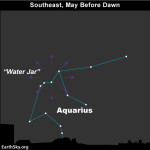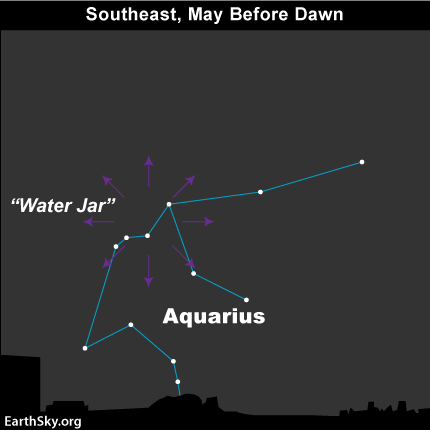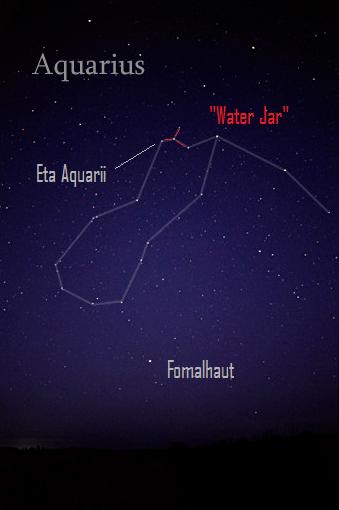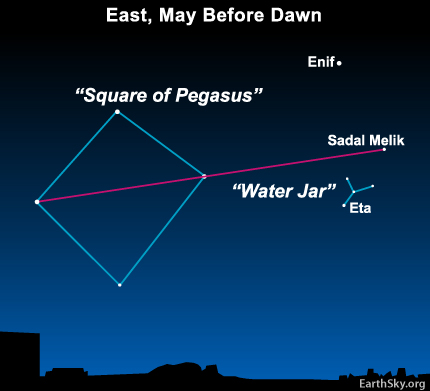

Eta Aquarid meteors appear to radiate from near a famous asterism – or noticeable star pattern – called the Water Jar in Aquarius.
The annual Eta Aquariid meteor shower peaks this weekend, and people will inevitably ask about its radiant point. That’s point in the sky from which meteors in annual showers appear to radiate.
You don’t have to locate the radiant to watch the Eta Aquariid meteors. Instead, the meteors will appear unexpectedly in all parts of the sky. Yet if you traced their paths backwards, all of these meteors would appear to radiate from a single point in our sky, from a Y-shaped group of stars – an asterism – called the Water Jar in the constellation Aquarius.

The Y-shaped Water Jar marks the radiant of the Eta Aquarid meteor shower. Notice the bright star Fomalhaut. It can guide your eye to much-fainter Aquarius.
Aquarius is faint. You’ll need a dark sky to spot it. The bright star Fomalhaut in the constellation Pisces Austrinus, the Southern Fish, is near it and can guide your eye. On old star charts, the Aquarius the Water Carrier is often pictured pouring water into the open mouth of the Southern Fish, from the Water Jar. In a very dark sky, you can see a zig zag line of star leading downward from the Water Jar to the star Fomalhaut.
Or try star-hopping to the Water Jar from the Great Square of Pegasus (see star chart below). Four medium-bright stars mark the corners of the Square. Looking eastward at about 4 a.m. (Daylight Saving Time) in May, the Great Square of Pegasus glitters like a celestial baseball diamond. Imagine the bottom star as home base. Draw a line from the third base star through the first base star, then go twice that distance to locate the star Sadal Melik in Aquarius.
To the lower left of Sadal Melik is the small Y-shaped Water Jar, marking the approximate radiant of the Eta Aquarid meteor shower.

Use the Great Square of Pegasus to star-hop to the radiant of the Eta Aquariid meteor shower.
Bottom line: Eta Aquariid meteors radiate from the Water Jar in the constellation Aquarius. Just remember, you don’t need to know the shower’s radiant point to watch the meteors!
from EarthSky https://ift.tt/2FGPc2L


Eta Aquarid meteors appear to radiate from near a famous asterism – or noticeable star pattern – called the Water Jar in Aquarius.
The annual Eta Aquariid meteor shower peaks this weekend, and people will inevitably ask about its radiant point. That’s point in the sky from which meteors in annual showers appear to radiate.
You don’t have to locate the radiant to watch the Eta Aquariid meteors. Instead, the meteors will appear unexpectedly in all parts of the sky. Yet if you traced their paths backwards, all of these meteors would appear to radiate from a single point in our sky, from a Y-shaped group of stars – an asterism – called the Water Jar in the constellation Aquarius.

The Y-shaped Water Jar marks the radiant of the Eta Aquarid meteor shower. Notice the bright star Fomalhaut. It can guide your eye to much-fainter Aquarius.
Aquarius is faint. You’ll need a dark sky to spot it. The bright star Fomalhaut in the constellation Pisces Austrinus, the Southern Fish, is near it and can guide your eye. On old star charts, the Aquarius the Water Carrier is often pictured pouring water into the open mouth of the Southern Fish, from the Water Jar. In a very dark sky, you can see a zig zag line of star leading downward from the Water Jar to the star Fomalhaut.
Or try star-hopping to the Water Jar from the Great Square of Pegasus (see star chart below). Four medium-bright stars mark the corners of the Square. Looking eastward at about 4 a.m. (Daylight Saving Time) in May, the Great Square of Pegasus glitters like a celestial baseball diamond. Imagine the bottom star as home base. Draw a line from the third base star through the first base star, then go twice that distance to locate the star Sadal Melik in Aquarius.
To the lower left of Sadal Melik is the small Y-shaped Water Jar, marking the approximate radiant of the Eta Aquarid meteor shower.

Use the Great Square of Pegasus to star-hop to the radiant of the Eta Aquariid meteor shower.
Bottom line: Eta Aquariid meteors radiate from the Water Jar in the constellation Aquarius. Just remember, you don’t need to know the shower’s radiant point to watch the meteors!
from EarthSky https://ift.tt/2FGPc2L

Aucun commentaire:
Enregistrer un commentaire